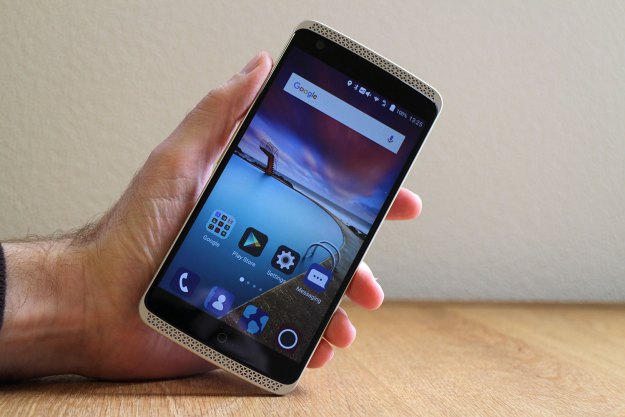
“ZTE’s Axon Elite is flashy and fast, but too many extra features weigh it down.”
- Excellent camera
- Eye-catching design
- Premium materials
- Low price
- High performance processor
- Custom UI frustrates
- Eye and voice unlock unreliable
We know what you’re thinking: ZTE makes safe, solid smartphones that rarely amaze in specs or design. Not anymore, thanks to the all-new Axon brand, which aims to bring style and glitz to the Chinese brand’s hardware, along with some super specs and a low price to wow buyers. That’s quite a tall order, and it’s also an area of the smartphone market that’s getting increasingly crowded — OnePlus, Motorola, and Oppo all came out with strong hardware that doesn’t cost much money to buy.
The Axon Elite is a better specced version of the original Axon Pro, which launched in the U.S. earlier this year, and we first checked it out in September. Now we’ve had a chance to spend some time with the phone and get a better idea of what it’s like to live with on a daily basis. Is the Axon Elite all flash and no substance or a killer deal? Let’s find out.
Brash and eye-catching
ZTE wants you to know the Axon Elite has been ‘designed.’ It’s covered in different shapes, accents, materials, and quirky elements that separate it from the bland functional shape of older ZTE devices, as well as the somewhat bland OnePlus 2. The Elite is close to being ostentatious, and there’s a chance some will find it objectionable rather than visually exciting. The Axon Elite catches the eye like a Louis Vuitton bag, and not everyone will be able to pull off the look.
The aluminum alloy metal body feels great, but it’s bookended by leather-look plastic panels to give the antenna array some breathing space, an alternative to Apple-style plastic inserts. It’s different, but because it’s not leather, it cheapens the style in a way a simple plastic panel wouldn’t. Elsewhere, a triangle motif is extensively used, and while it looks cool in-between the two camera lenses, it’s too much on the front panel, busying up the otherwise attractively shaped phone to the point of distraction.
This is no super-slim, featherweight phone, either. At 9.3mm thick and approximately 170 grams in weight, the Elite is hefty. However, this does mean it’s easy to grip and hold, plus there’s room for a sensible 3,000mAh battery inside the body. The battery pack lasted for about two days, even with heavy camera use, which is outstanding. The chassis is pleasantly shaped, so its size is visually masked, but there’s no getting away from the fact this is a big phone once it’s in your hand.
Triple unlock feature, but you only need one
A 5.5-inch, 1080p touchscreen is mounted on the front, and it sits slightly proud, with a curve blending it in with the body. Not only does the screen’s design look awesome, but it also feels great. ZTE made a feature of the curved 2.5D glass panel, so that it stands out more than when a screen is flush with the body of the phone. ZTE used anti-microbial Gorilla Glass, so it’s ideal for germaphobes such as myself.
How does the screen look? Putting it up against the
The primary differences between the U.S. Axon Pro and the Axon Elite are the three alternative security systems. The phone reads fingerprints, scans eyes, or recognizes your voice to unlock itself. The fingerprint sensor sits below the
The Axon Elite catches the eye like a Louis Vuitton bag.
It’s a good thing the fingerprint sensor is excellent, because the other two methods are too unreliable for everyday use. The Sky Eye eye-scanning system worked on average every three tries, and I often had to take my glasses off for it to work. If the sun is behind you when you want to unlock the phone outside, the scanner doesn’t work at all. Still, that’s better than the Voice Print, which never worked once, despite many attempts. Ultimately, the fingerprint sensor is all you need. The eye print recognition is very cool tech, but it’s just not fast enough for everyday use.
Excellent camera
The camera is the Axon Elite’s other big selling point. It’s a dual-lens 13-megapixel setup, which can create those fancy bokeh shots that are normally only possible with a DSLR. We’ve seen it on other devices in the past — HTC’s One M8 for example. You simply activate the mode, tap to take a photo, and then adjust the depth of field focus during editing. You can save multiple versions of the same photo, which is handy, and the f-stop is adjustable, although adjusting that metric never seemed to make a massive amount of difference. In fact, pictures came out much darker using the bokeh mode than with auto mode.
Even without the clever bokeh mode, the Axon Elite’s camera takes excellent pictures. On a very overcast day, it made the best out of the poor light, and produced atmospheric pictures on a windswept beach. It also took bright colorful images when the sun came out the next day. Only in a concert venue did it fail, the bright stage lights washed out the performers and left them looking like Mr. Burns after his ‘treatment.’
ZTE’s excellent camera app also includes a comprehensive manual mode, that’s almost as intuitive to use as LG’s, plus a slow motion video setting, and a burst mode. The more you play around with the app and its settings, the better pictures you can take. The camera encourages you to take pictures, and to experiment — which something I really like. The camera is my favorite aspect of the phone.
Fast processor makes it great for games
The controversial Qualcomm Snapdragon 810 powers the Axon Elite, along with 3GB of RAM. It’s notorious for getting rather hot, to the point where it has ruined other phones in the past. There are no such problems here, thanks to some clever fettling by ZTE to keep everything running at a sensible temperature. The changes are not at a processor level, but part of the body itself, where new heat sinks provide effective cooling for the hot chip.
If it weren’t for MiFavor3.2, we’d have no hesitation in recommending the Axon Elite.
Pushing the 810 with the graphically intensive Riptide GP2 game and the Mikuture live photo filter app saw an increase in body temperature as expected, but never to the point where it was out of control. Under normal use, the phone hardly became warm to the touch. According to the Geekbench 3 benchmarking app, the 810 clocks in at 1.5GHz.
The Axon Elite scored 3,921 points in the multi-core Geekbench test. On 3D Mark’s Slingshot ES 3.1 gaming test, it returned 1,192. The latter is higher than both the OnePlus 2 and the LG G Flex 2, while the former is comparable to LG’s last 810-powered phone, but lower than the OnePlus 2 with its 4GB of
ZTE’s custom Android UI lets it down
Android 5.0 is installed, but with ZTE’s MiFavor3.2 user interface over the top. As usual, this is a mixed bag. Speed isn’t a problem, but there are way too many pre-installed apps, no
OnePlus made the right decision with OxygenOS. It’s almost completely standard
Which apps are good enough to remain? The pre-installed music app is good, and it comes with Dolby Digital Plus for great audio using
Most annoyingly of all is the Mi-Assistant, which cleans up files, deals with security, and handles other behind-the-scenes optimization tasks. It also closes open apps when you unlock the phone under the guise of performance enhancement, each and every time, until you curate a whitelist. It played havoc with
Warranty information
ZTE USA offers a one-year non-transferrable warranty on its phones, which includes a repair-or-replace system that may include refurbished parts, should the phone be found faulty. You’ll need proof of purchase to make a claim, so make sure you register the phone online and keep all the paperwork from the sale.
Conclusion
ZTE’s Axon Elite is a good buy. It’s well priced, the camera’s fantastic, and it’s just as fast and high performance as phones costing twice as much — the Sony Xperia Z5 and the HTC One M9, for example. It’s the antithesis of the OnePlus 2, a phone with which it’s competing closely. Both cost less than £280 in the U.K. — where the Axon Elite is sold — and it overcomes the OnePlus 2’s major problem — dullness — with its brash design.
The DT Accessory Pack
Up your game with these accessories, hand picked by DT editors:
LG Watch Urbane Wearable Smart Watch in Gold ($279)
Beats Solo 2 in Gold ($300)
Louis Vuitton Damier Azur Canvas Speedy Bandouliere
It does throws away some of this goodwill away because of MiFavor’s alterations to
Choosing between the two may come down to your personality. Restrained and minimalistic? Take the OnePlus 2. Prefer something flashier and more exciting? It’s the Axon Elite all the way. If it weren’t for MiFavor3.2, we’d have no hesitation in recommending the Axon Elite. Hear that ZTE? With stock
The Axon Elite is also not available in the United States, which is a major downside. The Axon Pro, which is meant for the States, doesn’t have the fingerprint sensor, though it does offer most of the same specs for a low price of $400 unlocked. It also sports a more pure version of
Although we enjoyed the Axon Elite’s camera, flashy design, and high-end specs, the interference from ZTE’s UI and its lack of availability in the U.S. are major deterrents for would-be buyers. We’d recommend the Moto X Style instead for those looking for similar specs at the $400 price point. If you’re willing to spend more, the Nexus 6P is another excellent option at $500, and it has pure
Highs
- Excellent camera
- Eye-catching design
- Premium materials
- Low price
- High performance processor
Lows
- Custom UI frustrates
- Eye and voice unlock unreliable


























